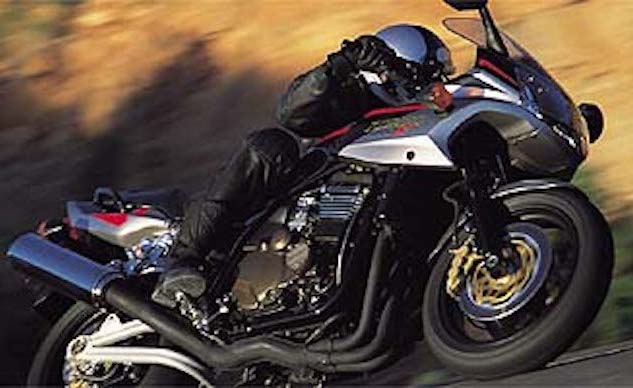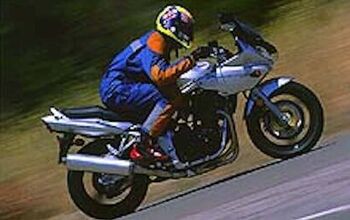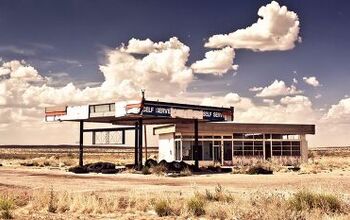Church of MO: 2001 Kawasaki ZRX1200S

Much like the Holy Trinity, the Motorcycle Online Staff in those days, 20 years ago, was able to coalesce as One, to write road tests in the first person singular from anywhere in the world. Kawasaki’s new ZRX1200 would go on to achieve cult status, though I, the MO Staff, don’t believe the “S” model tested here ever made it to the New World. It barely matters, since the photos are barely discernible anyway (and our slightly better lead image looks like it came from the press kit). The “S” had a slightly larger fairing than the ZX1200R, which appeared in America later in 2001. Let us all observe a moment of silence in honor of bandwidth.
———————————————————————————————-
2001 Kawasaki ZRX1200S
Seventies on Steroids
North-south-hampton-ridge-shire, 28 June 2001 — “They don’t make ’em like they used to.” Or so goes the popular expression. I beg to differ, though. I’ve just finished testing the bike that proves this old cliché wrong — Kawasaki’s ZRX1200S.The ZRX1200S has been deliberately built in the image of the bikes of the seventies. It has a simple frame, twin shock rear suspension and a big, ballsy engine that hangs out in the breeze for all to see. The riding experience owes a lot to the seventies’ universal Japanese motorcycle (UJM) that the big Zedder is so blatantly modeled on. For a start, you sit on the bike, rather than in it as with many of the modern sport bikes.
The bars are wide, fairly high, and made of tubular steel unlike the stubby alloy clip-ons that grace so many bikes nowadays. It has a broad saddle, built for comfort, actually containing more than one millimeter of padding between your arse and the pan. The footpegs aren’t placed in a cruiser position, but then they aren’t set too far back and too high like on a hyper-sports machine. In other words, you’re now sitting as you might have done when riding your CB750, Z900 or GS750 all those years ago.
In the seventies, Honda and Kawasaki sold their big fours by the truck-load. With this ZRX1200, Kawasaki has tried to recapture some of that early glory — and sales.Fire up the big ZZ-R1100 derived engine and you are greeted with a mechanical rustle that’s similar to any UJM from the Seventies. But click the bike into gear, let out the clutch and twist the throttle for the first sign that this is a modern and much improved upon version of the UJM theme.
“This bike is fast — effortlessly so — as you might expect from a bike with an engine transplanted from the once mighty ZZ-R1100.”
This ZRX is completely different than the UJMs of the past that needed to be worked hard. Those early bikes only gave their best effort very near the redline. The ZRX1200 is very different.
Even suffering from the massive burden of emission and noise regulations, the latest incarnation of the Zed range is much quicker than any of the machines it pays homage to. Getting the mix of outright power and flexibility just right is a challenge to engineers in these days of stringent emission controls. Still, the Kawasaki, with a bank of four carburetors and a catalytic converter hidden in its end can does an admirable job. It’s especially quick where it matters most — the mid range. If you have anything more than 2,000 revs on the tach and take a big handful of throttle, the bike hurtles forward like a greyhound on amphetamines. The surge of power keeps building all the way to the redline at 10,500 rpm. The big motor is so flexible, it allows you to be very lazy with the gearbox. Once out of town, there’s no need to use any other gear except top.
The only flaw in this user-friendly power package is a slight hesitation off idle. This carburetion glitch also made its presence felt when shutting off suddenly from high speed. The engine felt like it had gone into a total shutdown mode when the throttle was snapped shut. Then, twisting open the throttle was sometimes met with a delay before the power surged in. The trait may have been peculiar to this individual machine, as it would also pop and bang through the exhaust pipe on overrun, possibly evidence of an air leak somewhere in the four-into-one system that might have upset the carburetion.
So, the ZRX will beat its UJM ancestors hands down in the motor department. Things are no different in the twisties. The Japanese were so obsessed with making their bikes fast in the seventies that they forgot to make them go around corners, too. In fact, they didn’t actually know how to build a chassis capable of handling the weight and power of their engines. Even the legendary Honda racers had an reputation for evil handling. Even the late, great Mike Hailwood reported that he would be in a bad mood for hours after wrestling the bikes around GP circuits.
The Japanese resorted to hiring European experts from the very motorcycle companies they had helped to destroy in an attempt to tame the wild. As you might expect from a bike with an engine transplanted from the once mighty ZZ-R1100, this Kawi is fast. The ZRX is completely different than the UJMs of the past that it pays homage to handling of both their race bikes and the road machines they were based on.
While the parts might look superficially similar to those fitted to the seventies UJMs, the components on the ZRX are far more sophisticated. The lay-down rear shocks, with their piggy back remote reservoirs, are adjustable for preload and damping and look the part. As does the massive reinforced swing arm, which has been designed to mimic something a UJM owner might have fitted as an aftermarket part in the seventies. Combined, the shocks and swinger do a good job of keeping the rear wheel planted and delivering the 122 horses made by the mighty motor. Up front, a pair of right way up forks do their bit in keeping the ZRX stable.
“Power needs control, and the six-pot front calipers grip a pair of tea-tray sized discs to keep things in check.”
They’re not up to the same (very high) standard of the kit found on almost any modern sport bike. The ZRX is relatively heavy at 500 pounds (227 kgs), and the wheelbase too long (1465mm) to expect sport bike-sharp handling. But despite the conservative steering geometry and the weight, the ZRX can be made (or is that forced?) to turn in hard and it will hold its line. The handlebars are long enough to provide plenty of leverage, so direction changes feel relatively easy. But at high speeds, changing lines mid corner requires the pilot to work hard to keep the ZRX on pace. The lay-down rear shocks, with their piggy back remote reservoirs, are adjustable for preload and damping and look the part. As does the massive, reinforced swing arm.
The combination of nicely sorted suspension combines with the weight and wheelbase to shrug off most bumps, though really hard going can induce a little “flap and jump” from the front end. The rear also isn’t too happy with very bumpy going, and the stiffly damped rear shocks will keep your own rear end informed of just how hard they are working. But the chassis works well enough that, when combined with the brilliant engine, the ZRX is perfectly capable of giving a few hyper-sports bike riders a surprise or two.
Power needs control, and the six-pot front calipers grip a pair of tea-tray sized discs to keep things in check. The brakes are very strong but need a good squeeze to get the best from them. They are a little wooden at lower speeds and you have to work them hard when you really need them. But, given effort, you’ll soon be lifting the rear wheel under heavy braking — and building up those forearm muscles. The rear disc is brilliant, powerful enough to lock the rear tire when you want to, but not so sensitive that it locks it when you don’t want to.
By “when you want to” I mean showing off, sliding the beast to a halt. This sort of behavior suggests the ZRX induces a little lunacy from its rider. I’d go along with that. I had so much fun that I started to take the piss. Spinning the rear tire at the lights, popping wheelies, stoppies and sliding the rear tire on the brakes when stopping in front of bemused schoolgirls is all good fun. If you’ve got the heart for this, you’ll have plenty of fun on the big Zed.
The standard ZRX shown here is one of three guises the bike is available in worldwide. Our personal favorite? The green Eddie Lawson replica, of course.The ZRX is available in three guises, the ZRX1200S model featured here, an “R” version with a bikini fairing that apes the original Z1100R, or the Eddy Lawson replica, so called because the American racer used one to win Superbike races in the USA in the days when Superbike racing really did mean road bikes on the track.
There’s also the standard unfaired model, the ZRX1200. Your choice would depend on what you want from the bike. The “R” model might be the best for those seeking the authentic looks of a late Seventies muscle bike. The naked version will suit those with strong necks — you’ll need one to hang on to the missile at 155 mph!
The fairing on the “S” isn’t faithful to the Seventies look, as it’s far too sleek and modern for that. But it does a brilliant job in keeping the rider comfortable. The airspace behind the fairing is completely still, even at 100 mph cruising speeds. I’m six foot tall and usually find the turbulence from this type of half-fairing knocking my head about. Not so on the ZRX, as the air coming over the top of the screen is steady at all speeds, leaving the cockpit a place of almost Buddhist tranquillity. This, combined with the effortless power of the engine, could have got me into big trouble. I often glanced down at the speedo on a motor-way to find my cruising speed had crept up to well over 100 mph. Things were so quiet and calm that I honestly hadn’t realized I was riding so fast, officer.
The ZRX’s seventies styling combined with 21st century technology won’t suit everyone. Bikers are individuals and some will want a bike that’s even more retro and others will want something cutting edge. But the ZRX is such a capable bike, and a damn fine looking one too, so it’s sure to find some takers. Those riders won’t be disappointed with Kawasaki’s latest version of a seventies UJM on steroids.
Specifications(U.S. ZRX1200R) Engine type : 4-stroke, DOHC, in-line 4, 16-valves Displacement : 1,164cc Starting : Electric Bore x Stroke : 79.0 x 59.4mm Cooling : Liquid Carburetion : Keihin CVK36 x 4 Ignition : Digital w/ Kawasaki Throttle Responsive Ignition Control (K-TRIC) Transmission : 5-speed Frame : Double cradle tubular steel Rake/trail : 25°/4.1 in. Suspension, front : 43mm telescopic fork with preload adjustment and 12-way adjustable compression and rebound damping Suspension, rear : Braced swingarm with twin shocks, 5-way adjustable preload and 4-way adjustable compression and rebound damping Wheel travel, front : 4.9 in. Wheel travel, rear : 4.6 in. Tire, front : 120/70ZR17 tubeless radial Tire, rear : 180/55ZR17 tubeless radial Brakes, front/rear : Dual hydraulic discs/Disc Overall length : 83.5 in. Overall width : 30.7 in. Overall height : 45.3 in. Wheelbase : 57.6 in. Ground clearance : 5.3 in. Seat height : 31.1 in. Dry weight : 500 lbs. Fuel capacity : 5.3 gal. Color : Candy Lime Green/Vivid Purple Mica, Black Pearl/Metallic Blue Violet MSRP : $7,899

Motorcycle.com presents an unrivaled combination of bike reviews and news written by industry experts
More by Motorcycle.com Staff

































Comments
Join the conversation
Best bike I ever owned. Actually, I still own it. But I'm waiting for my local dealer to get my '21 z900rs in so I can compare the 2, I'm looking forward to having EFi, ABS, 6sp trans, traction control, and monoshock rear, plus being lighter with close to the HP
Back when they came out, I would have had sex with a man for the Eddie Lawson replica. But, was in the middle of the divorcething/no money.
Still often look at the Craigs of Ohio/Michigan/Upstate New York for clean low mile versions.